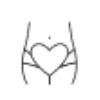Pamela Samuelson is a certified somatic sex educator, a multidisciplinary bodyworker, a feminist health and sexuality advocate, an orgasmic birth doula, the founder of the Feminist Health Alliance, a writer and activist, the mom of a clever daughter, and a lifelong dancer based in Los Angeles. More on her work at www.embodywork.la
Vulva Mapping:
An Experiential Guide to the Universe between Your Legs
In the late 1960s and early 1970s — in a world before Roe Vs. Wade had passed, before women could take out their own credit cards or bank loans, before sexual harassment was ever defined in a court of law — women began to attend feminist consciousness-raising groups.
As was recently portrayed in the now-defunct (though excellent) Amazon original show Good Girls Revolt, one of the activities famously offered at some of these meetings was for participants to look at their own vulvas with mirrors and flashlights, as a group.
Thinking back now about what looking at their own genitals meant to women in that cultural context is remarkable. Most of those women had never seen their own bodies before by themselves, let alone in a group of other women. Looking at themselves in that way challenged intense, long-held taboos around impropriety, self-sovereignty, and sexual ownership.
Furthermore, most of those women had never seen another woman’s body before, and so had no idea whether their own body looked like everyone else’s, or what the range of ‘normal’ actually includes.
Even today, this simple act — the act of a woman looking at her own body with a mirror — still makes people so uncomfortable that it’s become a cliche and a joke. Which leads us to ask: what is it about the claiming of the female sex organ by the person to whom it belongs that makes everybody so damn uncomfortable?
We believe that the comfort and discomfort of others is neither our business nor our responsibility — and that our own comfort is a matter of choosing to form the habits we would most enjoy living with.
So with that in mind, we turn to the matter at hand: your precious body.
If you haven’t already, check out this article on coming home to your body, and take some time to bravely, boldly, gently, and lovingly explore the seat of your awareness. The exercises in that article involve a gentle meditation that moves awareness out of the head and into the body. Sometimes, our discomfort can lock us out of the body — or certain parts of it — trapping us in the uneasy babble of the mind.
Although it might be challenging to close your eyes and become absorbed in the sensations of your left foot — at least you know what your left foot looks like...and you probably have convenient words for noting sensations: “Pinkie toe is numb. Big toe is warm.”
But what if you’ve never seen a certain part of your body? What if you don’t have the words to describe it? Or they’re words of scorn you learned from others?
Because your wondrous body is the seat of your consciousness, and because this body includes sexual and reproductive parts, we would like to provide an experiential road map for exploring and naming the parts of your own sexual anatomy, which you can easily see with a mirror.
This is the next in our series on coming home to your body. (Stay tuned for further explorations, including therapeutic vaginal massage.)
So, go ahead and grab a hand-mirror. Find a comfy, private place (bed, bath, or beyond).
Once you’re settled in, take a deep breath, and drop your pants. If you’ve never really done this, you may be surprised by the experience.
A Note on Language
The female sexual organ has gone by many names. Some of us might enjoy direct, blunt language — and fondly call it pussy, or cunt. Others feel more warmth in words like yoni, or flower, or punani, or coochie, or other, sweeter nicknames. Many prefer the medical simplicity of vulva or vagina. For some, it’s like describing a blind spot, “down there.” (And of course there are endless names for the female sex organ that relegate it to its function as an object of male desire and pleasure — not a single one of which deserve our attention or amplification here.)
Naming the female sex organ according to our own preferences is of enormous importance, simply because naming it asserts our unique connection to and our power over our own bodies. Additionally, there’s the simple facts that we can’t talk about something (or even think of it much) if we can’t call it by name.
To refuse to name our parts, consciously or unconsciously, is to obscure their reality, as if to erase them — maintaining a blind spot out of shame.
Saying the words we choose has the opposite effect. When we name the sexual parts of our own bodies, we render them accessible and real to ourselves, and make it possible to communicate about them with others as a completely normal aspect of life in a body. These people could include:
- your lover, whom you’d like to show how you like to be touched.
- your doctor, whom you want to ask direct questions and get accurate information from during an exam.
- your BFF, with whom you might want to compare notes about masturbation techniques.
- And so on.
In a few moments, we’ll be exploring all the names and parts of the external female sexual anatomy — those beautiful, sensitive, delightful powerhouse organs between our legs. You’ll be speaking the words that are essential to living a sensual, embodied life, in full ownership of all that is rightly yours. Knowledge really is power.
How do YOU like to Refer to your Sexual Organs?
For the purpose of this article, we will be using the word ‘vulva’, which we prefer in this context for its neutrality. As we talk through each part, please do follow along with your eyes — as well as your fingers!
Your Temple Grounds
Your vulva is everything that lies from your pubic mound (the padded place over your pubic bone, where your pubic hair starts), to your perineum (the mighty bridge of muscle that you can see between your vaginal opening and your anus, often called the “tween” or “taint”).
As Unique As Your Face
The first thing most of us notice is our two sets of lips, or labia: inner labia and outer labia. Contrary to the vulvas most commonly seen on the internet (most looking somewhat alike) there are as many variations in vulva shape and color and texture and symmetry as there are vulvas in the world. Like faces, literally no two vulvas are the same! Some people have bigger inner labia; some people have bigger outer labia. Many people’s lips are asymmetrical in one way or another. Some women’s inner lips flare into extraordinary orchid-like shapes; some women’s inner lips are neatly tucked away inside the more prominent outer lips. All of that is absolutely, 100% normal and lovely.
A Major Misnomer
Please note that we’ve deliberately avoided the common medical terminology labia majora, (“big lips”) and labia minora (“small lips”). For plenty of women, the inner lips are significantly bigger than the outer lips. Not only are majora and minora inaccurate, they perpetuate genital shaming. The landmark book A New View of a Woman’s Body originally proposed the terms inner and outer labia — and we find these to be perfectly accurate and inclusive. (Feel free to take a red pen to any anatomy book you may come across to correct this!)
The Convergence
Your outer lips come together at the very center of your pubic bone at a place called the front commissure. Immediately below the front commissure, the texture and color of the skin changes, and there you will find the hood of your clitoris covering the shaft of your clitoris and sometimes also the glans of your clitoris, at the tip of the shaft. Roll your fingers over the vertical ridge of your shaft to feel its exact shape and location, and to explore your sensations there.
Under The Surface
If you explore with your fingers at the commissure, you can sometimes feel that there is a little vertical ridge running towards your navel, like a continuation of the clitoral shaft up into the pubic bone. This is the suspensory ligament, which suspends the clitoral shaft from the bone and assists with clitoral erections. (Did you know you get erections when you’re turned on? You do!)
Her Majesty: the Clitoris
If you can’t see your clitoral glans because your hood completely covers it up (true for many people), you can use your fingertips to gently manipulate and pull back on your clitoral hood until you can clearly see the glans. This is an analogous motion as one would make with an uncircumcised penis to reveal the head — in fact, these tissues begin as the same structures in a fetus before sex differentiation begins, about 7 weeks after conception.
The clitoris — of which the hood, shaft and glans are the external, visible parts — is the most nerve-dense part of your body, packing about twice the number of nerve endings as a penis despite being approximately one-eighth the size, and its one and only function is to provide you with sensation. Some clitorises are the size of a tiny pearl and others are the size of a baby carrot, and the entire range of clitoral size is 100% normal.
The unseen parts of your clitoris include your vestibular bulbs, which extend from the shaft all the way down and around your urethral and vaginal openings, and the legs (also called crura) which extend deep into the pelvis. Just like your external clitoris, the bulbs are largely composed of erectile tissue and are sensitive to touch, and you can clearly feel them underneath your outer labia when you’re aroused and they are erect. Many people hugely enjoy stimulation there.
Friends of the Frenulum
Just below the glans is where your inner labia come together at the top of your vulva, at the frenulum of the clitoris. This is the homologue — the analogous part — for where the foreskin attaches on an uncircumcised penis.
If you part your inner lips and look in the mirror, you can see exactly where this bridge of tissue is, and if you pull gently on your inner labia on both sides, you can see and feel the structural relationship the inner labia and their attachment at the frenulum have on the structure of your clitoris. This hidden, protected area between the inner labia is sometimes charmingly called the vestibule, which is another word for an entrance chamber.
Fluid Origins
With your inner lips parted, you can look below the frenulum for your urethral opening, which is where urine comes out. It is very easy to see on some people and more difficult on others, but you can almost certainly find it if you look carefully.
Even smaller but also often visible on either side of the urethral opening are the paraurethral glands (often called Skene’s glands in anatomical texts), which are now widely medically acknowledged as “the female prostate” and which produce varying amounts of fluid ejaculate in those of us who squirt.
The opening of your vagina, sometimes called your introitus, is separate from the urethral opening, and is the larger opening closer to your anus.
On either side of the vaginal opening, visible on some people, are the vulvovaginal glands (usually called Bartholin’s glands in anatomical texts), which produce the natural lubrication or wetness we feel when we’re aroused.
Exploring Deeper
At the entrance to the vagina, you may or may not have OR EVER HAVE HAD a hymen, which, like every other aspect of the female sex organ, varies enormously from person to person. (For information on this and much, much more, we recommend picking up a copy of Emily Nagoski’s Come As You Are, which addresses the mythology of hymens and their cultural cache.)
The interior of the vagina, far from being the oft-pictured cylindrical shape, is more of a muscular accordion, a sort of magical inner space that expands and shrinks at will according to your state of arousal, hormonal conditions, and many other factors. (More on that in our next piece!)
Powerful Pelvis
Just below the introitus, your inner lips meet at the fourchette, or “little fork.” And just below the fourchette is the perineum, the dense, muscular crossbeam of the pelvic floor. You can clearly see and appreciate the strength of the perineum by squeezing your pelvic floor muscles (as you would when doing a kegel exercise). Try and see what you notice in the mirror as you do.
The fourchette and perineum are the most common site of vaginal birth injuries from tearing or from episiotomy. If you have had a vaginal delivery, really take a moment to look at this part of your body, to connect with it, and to explore with your fingers — we will have more information for you very soon on how one can work with and resolve scar tissue from these injuries (as we can with any trauma that causes scarring).
The Look of Love
As you finish your guided tour, take a moment to really see your vulva as a whole. Notice your contours and colors, the shape and the style of your sexual anatomy.
Do you have different feelings about it than you did before learning its parts and names? Do you feel more comfortable seeing it, and perhaps having it be seen by others?
We hope that this information opens the way for you to feel that you belong in your body, and that you feel more and more comfortable claiming your power and your perfection.
With love,
Foria
Want more? Sign up for our newsletter
By entering your email, you are agreeing to our terms and conditions and understand our privacy policy.








